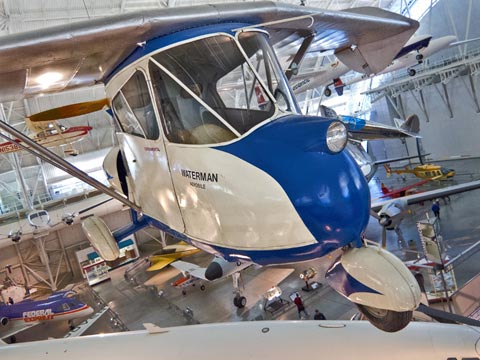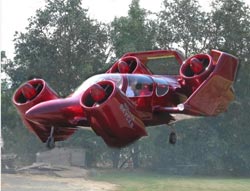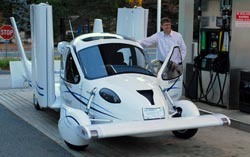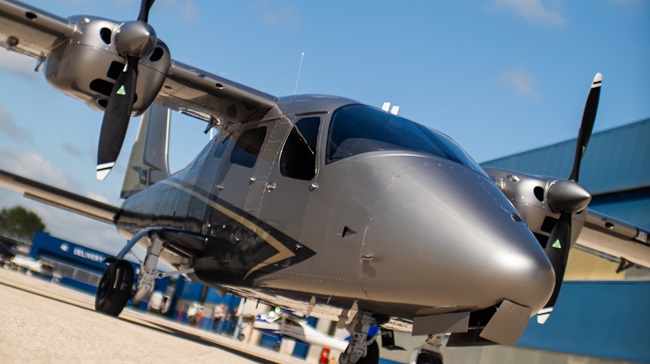Dream of driving airplanes is alive
Designers may be on the cusp of a breakout

A century of failed attempts has not dampened dogged enthusiasm for developing a car that flies (well), produced in sufficient numbers to unclog crowded roads and change the way we travel. From Massachusetts to the Mojave Desert, and around the world, corporations and backyard builders are fine-tuning designs, hopeful of being the first to deliver a useful aircraft, in numbers, to home garages built for cars.
Some believe the tipping point is at hand, and technology could usher in a new golden age for general aviation.
The concept of being able to drive and fly in a single convertible vehicle is nearly as old as the airplane and automobile. John Brown, editor of the Roadable Times website and author of All the World’s Flying Cars, which will be published (in German, first) in May, has traced the origin of the flying car back years before a 1916-17 effort by Glenn Curtiss that did little more than hop, an attempt widely credited as the birth of the concept. In 1911, Brown said, a successful prototype appeared at the Paris Air Show, having passed French military aviation trials and driven through the streets of Paris to the show.
“This goes back a long, long way,” said Brown, a former airline pilot who works for German startup Carplane, now vying to get a bipod, swing-wing, flying car, or roadable aircraft off of the drawing board.
While the history of flying cars has been marred by a few eye-popping catastrophes (Henry Smolinski attempted to mate a Ford Pinto—yes, a Pinto—with a Cessna Skymaster and died in an in-flight breakup), investors have in recent years poured millions of dollars into dozens of new designs, a few of which have flown. Terrafugia, founded by Massachusetts Institute of Technology graduates, is about to introduce the Transition, a street legal light sport aircraft first flown in 2009, to the New York International Auto Show in April.
Terrafugia CEO Carl Dietrich said the two-seat Transition itself will not revolutionize human travel, but its descendants could be produced in sufficient numbers to reduce highway congestion and transform transportation.
“As a company we are positioning to have that sort of large, long-term impact,” Dietrich said.

Skeptics, and there are many, include the curatorial staff at the Smithsonian National Air and Space Museum, which has collected three examples of flying cars that succeeded as aircraft, but not in the marketplace. The 1937 Waterman Aerobile, a tricycle design with a removable wing, is one such footnote in aviation history.
“These have never been practical,” said Dom Pisano, aeronautics division curator at the Smithsonian. “What strikes me, though, and probably you, too, is the idea just never seems to go away.”
Brown traced a shift in the popular conversation to the November 1947 forced landing of a prototype Model 118 ConvAirCar, which left the air/road craft badly damaged and tainted the sentiment surrounding the flying car concept.
“Articles before that, all they ever wrote is, ‘this is the future,’” Brown said. “You can trace the references to the Jetsons, the so-called craziness factor … you can trace it back to December 1947.”
In 2011, Burt Rutan’s BiPod changed the conversation again, Brown said. Liberal use of words like “crazy” or “farfetched” in media coverage of flying cars “abruptly stopped in July of last year,” Brown said, adding that transition had begun with the first flights—in ground effect—of the Transition in 2009.
 The Moller Skycar, which achieved liftoff in 2003, is not designed to drive on roads, but solve the transportation equation with vertical takeoff and landing.
The Moller Skycar, which achieved liftoff in 2003, is not designed to drive on roads, but solve the transportation equation with vertical takeoff and landing.
There are more than two dozen specific technical challenges. Brown ticked off the four most difficult, starting with road width. On the ground, wings must be folded or otherwise stowed—or left at the airport. Engineers of the Maverick, built to transport missionaries across rugged, remote jungles and mountains, solved the problem with a powered parachute design, trading airspeed for ease of operation.
Cars are designed to hug roads, and automotive engineers crave down force. Aeronautical engineers need the opposite.
“Almost 300 flying cars have flown in the last hundred years, but there haven’t been any commercial successes primarily for that reason,” Brown said.
Aircraft and automobiles have different requirements for weight and balance; automotive engines are typically liquid cooled (easily able to pay the weight penalty for more efficient cooling). Advances in engine design, and the introduction of high-strength, low-weight composites, along with other advanced materials, has helped tip the balance.
 Terrafugia CEO Carl Dietrich fills a Transition with premium unleaded. Photo courtesy Terrafugia.
Terrafugia CEO Carl Dietrich fills a Transition with premium unleaded. Photo courtesy Terrafugia.
“I think the technology is finally getting there where these things are for real,” said Florida transportation engineer Jeffrey W. Buckholz. “I see it as the next quantum leap in transportation … something that will revolutionize the transportation industry.”
Buckholz, who published a peer-reviewed paper on the topic in 2010, built a website, ranking a few of the current projects.
A successful design would solve one of the central quandaries of general aviation: A trip from Point A to Point B requires ground transportation to the airport, an aircraft to fly to a distant airport, and then a rental car, taxi, or portable transportation that can be carried in the aircraft to reach the ultimate destination. Folding bikes or motorcycle pods have drawbacks, including a loss of useful load in the aircraft.
Terrafugia, while working within a 1,430-pound weight limit (allowed by an FAA waiver of the light sport aircraft limit of 1,320 pounds), has included automotive safety features such as air bags and crumple zones, and a ballistic parachute. While the expected list price has soared from $148,000 to $279,000, driven mainly by the need to incorporate high-cost, low-weight materials, Dietrich said the company now holds nearly 100 refundable deposits from buyers. Making GA a practical travel option for a sport pilot could quickly reverse the decline in the pilot population, according to Brown, Buckholz, and Dietrich.
“It’s the lowest price point aircraft that you can count on to get you where you want to go in real IMC,” Dietrich said. “You’re not flying the Transition in that, but you’re still getting there.”

While test flights to date have stayed above the runway, the Transition has left ground effect and reached altitudes of 300 feet. Dietrich said the first deliveries could be made late this year or in early 2013. Brown said production costs should decline with volume, just as they did with the automobile.
MIT Professor of Aeronautics and Astronautics R. John Hansman, whose former students are building the Transition and current students are testing sophisticated cockpit collision warning algorithms, said promise of a flying car explains much of the persistence of the dream.
“If you could do it practically, which I’m not sure you can, there’s a huge market, and you get huge utility out of the vehicle,” Hansman said. “If you had one vehicle that could do both jobs, that would be cool. … The market demand has always been there.”
Pisano said he hopes to add a Terrafugia to the Smithsonian collection—whether or not it succeeds commercially.
“I think people would go crazy to see it, you know?” Pisano said.



